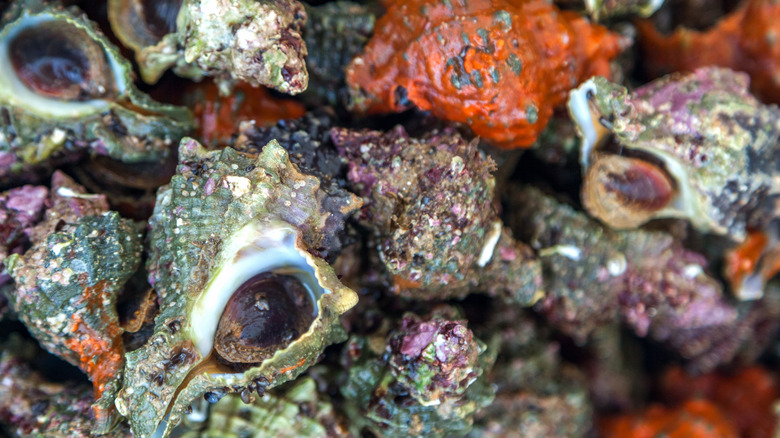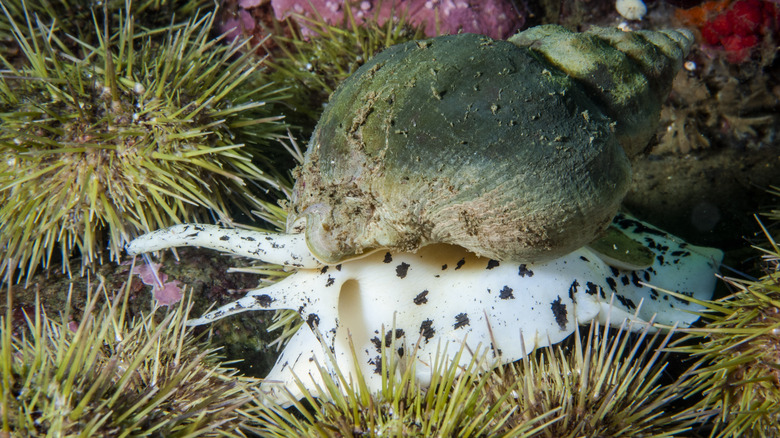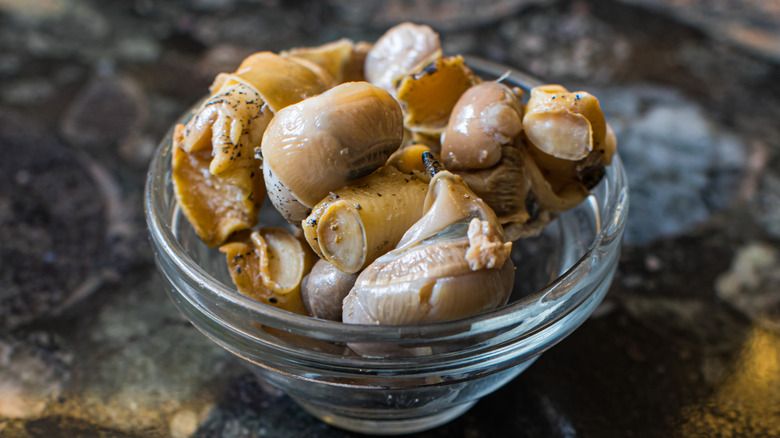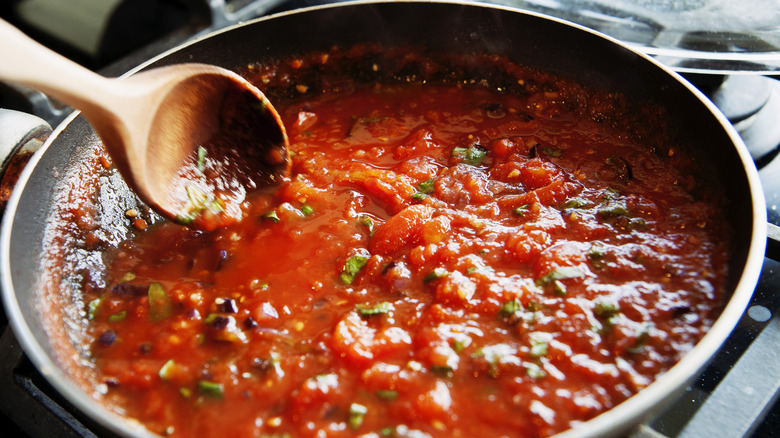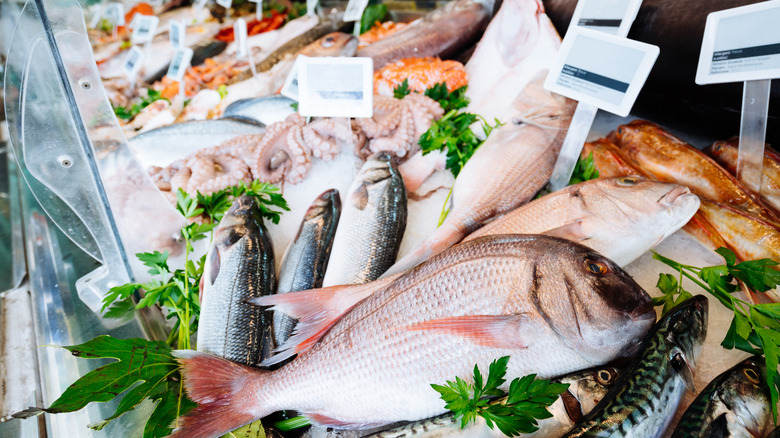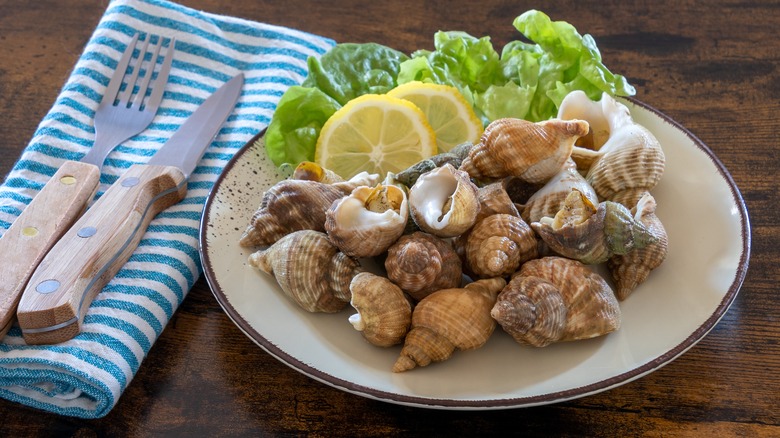What Is Scungilli?
The Feast of the Seven Fishes is a Christmas Eve staple for people of Italian heritage living in America. The holiday tradition got its start when Italian immigrants first made their way to the United States during the 1900s. Combining seafood with traditional Italian cuisine was a way for newcomers to celebrate and remember their home country in a new land, and the tradition has remained strong through subsequent generations. While Christmas Eve menus vary from family to family in Italian households, many celebrations include specific seafood dishes.
Among more conventional preparations featuring lobster, calamari, and clams sits scungilli, a surprising ingredient beloved by those who've had the pleasure of sampling it. While scungilli can be added to sauce for a bold and memorable flavor, it's most often served in a cold seafood salad.
And while it's a major ingredient in Italian-American households, scungilli is still unknown to many people.
What is scungilli?
Scungilli is taken from the Italian word sconsiglio, which is Neapolitan for conch, a type of sea snail. However, scungilli is actually considered a whelk, as conchs are found in the southern part of the Atlantic Ocean. Whelks are native to North Atlantic waters, as well as the connecting bays and sounds where they're usually fished. Whelks can reach up to nine inches in length and often weigh three or more pounds.
While many scungilli dishes use canned varieties, whelks can also be bought fresh. However, preparing fresh whelks is quite labor-intensive and can result in a rubbery texture if the seafood is cooked for too long. Cooking steps include freezing overnight, gently simmering in water, taking the whelk out of the shell, and then removing inedible components, such as the stomach sack and the operculum, a sturdy plate that keeps the snail safe in its shell.
Whether you choose to take the hard road or opt for the more convenient canned version, you're in for a real treat when it comes to scungilli's flavor.
How does scungilli taste?
Fish and other types of seafood sometimes earn a bad reputation for being too "fishy" when it comes to aroma and flavor. In fact, quality seafood should never give off a pungent fish smell, as this indicates that the catch is not fresh. This has much to do with a chemical called triethylamine, which converts to ammonia the longer the fish is exposed to the air. That means a fishy-smelling fish has likely been sitting around for some time.
Like all of the best fresh seafood, scungilli lacks an overwhelming fishy flavor. Instead, the meat of these aquatic snails is known for its subtly sweet, mildly salty taste that exemplifies the freshness of its ocean home. As for the texture of the dish, scungilli is comparable to calamari.
Like calamari, scungilli tends to be pleasantly chewy, although never rubbery when prepared correctly. Instead, the meat of the snail should be firm and toothsome, with some springiness while chewing. By properly cooking the seafood, you can rest assured of preserving this enjoyable texture.
Cooking with scungilli
Based on the fresh and salty flavor profile of scungilli, it's an excellent addition to salads. That's why it's commonly served cold during the Feast of the Seven Fishes, as the brininess of whelk meat pairs beautifully with fresh vegetables. While you're free to develop your own salad recipe, scungilli works well with onions, celery, and parsley. For added flavor, many chefs incorporate ingredients such as garlic, capers, and green olives. Additionally, fresh lemon juice is incorporated into the salad to bring out the inherent flavor of the scungilli, as the acidity of citrus fruits pairs well with this seafood.
To ensure the flavors of the salad blend beautifully, prepare it the night before and allow it to chill in the refrigerator until you're ready to serve it.
You can also add canned scungilli to tomato sauce when preparing pasta dishes. In this case, sliced scungilli can be added to the sauce when it's almost done cooking, which ensures the meat won't become too tough. In addition to the base of tomato puree, scungilli sauce can also be enhanced with the addition of clam juice and anchovies, as well as assorted seasonings such as parsley, red pepper flakes, garlic cloves, and oregano. Now that your appetite is sufficiently whetted, where can you find scungilli?
How to buy scungilli
If you're lucky enough to have an authentic Italian market where you live, you can probably find canned scungilli there. Because the ingredient is so vital to Italian Americans, particularly around the holiday season, all good Italian markets should carry it. Supermarkets with sections dedicated to different world cuisines may also carry the canned version, which often come in original and petite varieties. Most canned varieties include several species of sea snails in addition to the whelk most often associated with scungilli.
If you're seeking fresh whelk, you may have your work cut out for you. While you may be able to find live whelks at your fish market if you live in an area where they're routinely fished (such as locations in Maine or Massachusetts), they're often hard to come by in other areas of the country. However, you may be able to find frozen whelk meat at select seafood retailers. You can also have it shipped direct to your door.
In this case, you can keep frozen whelks for about six months before the quality degrades. Of course, you won't want to neglect this delectable seafood for too long when you learn just how beneficial it is to your health.
Is scungilli nutritious?
While scungilli is most notable for its fresh, ocean-tinged flavors, whelks are also brimming with nutritional value. With 27 grams of protein per every four-ounce serving, whelk offers amazing benefits when it comes to cell repair. And based on their lower fat content, they're ideal for people looking to boost nutrition without increasing their fat intake.
Whelks also enhance heart health, thanks to the presence of omega-3 fatty acids, which are powerful antioxidants that fight free radical damage throughout the body. Additionally, whelks are rich in vitamins B12 and E, as well as minerals such as iron, zinc, and copper.
When the same old seafood dishes are decidedly ho-hum, why not give scungilli a try? While you can probably find it on the menu at your favorite old-school Italian establishment, buying the canned version allows you to experiment with new recipes at home. Offering a combination of unbeatable flavors and incredible nutrition, scungilli will be the shining star of your kitchen.
